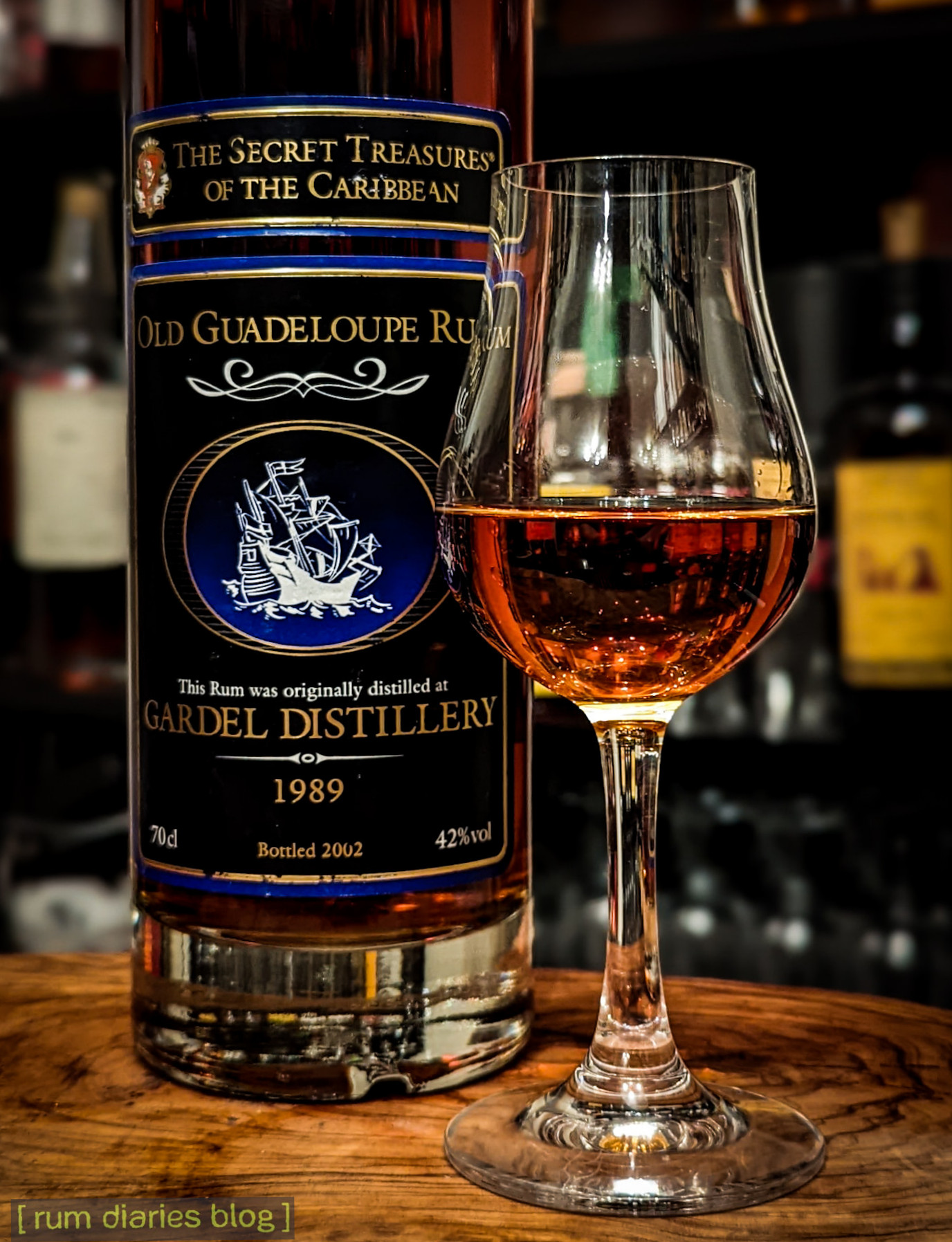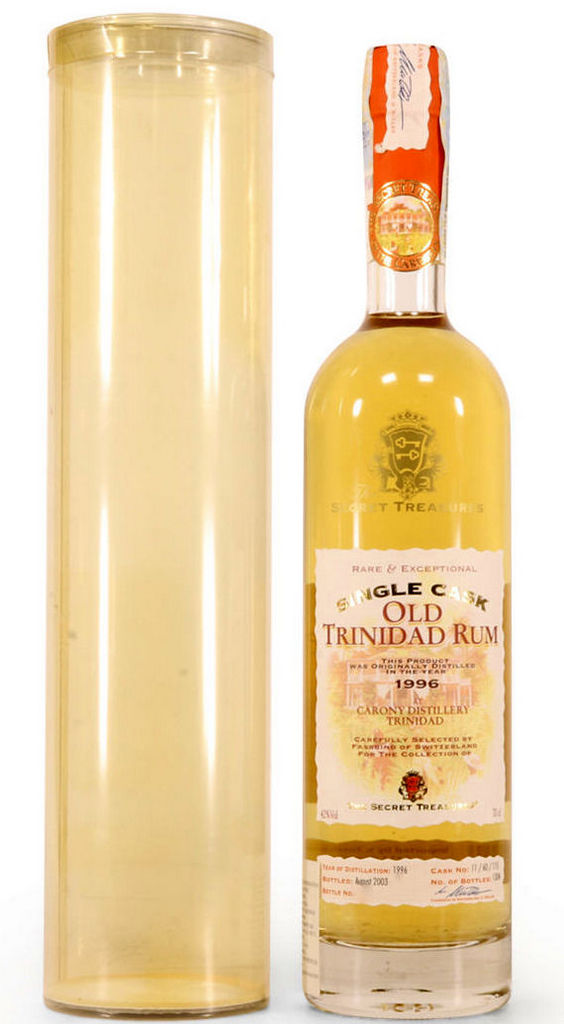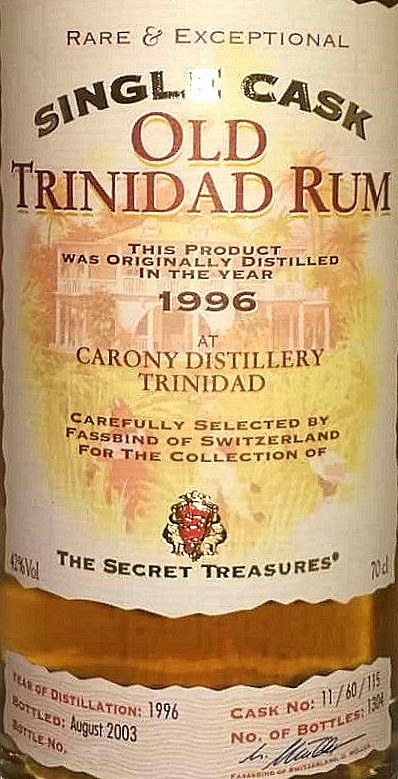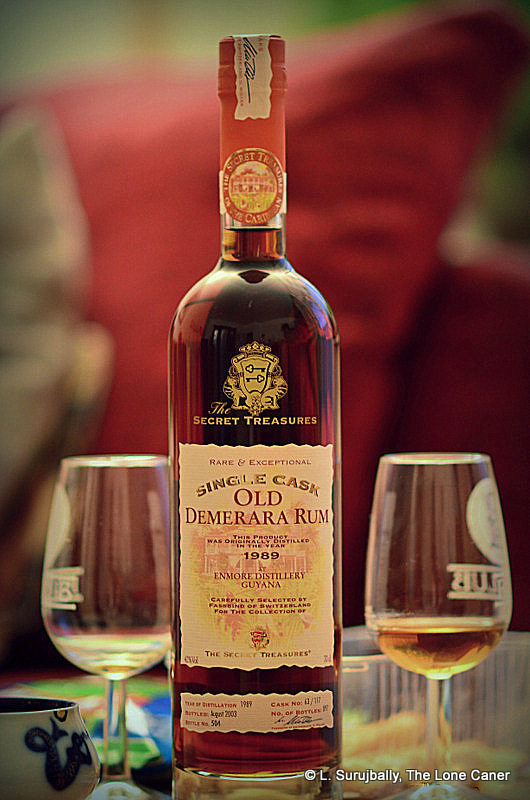
Photo courtesy of Steve James at The Rum Diaries Blog, who kindly chipped in after my own photo got corrupted.
The clear, light, and distinct nose on this Guadeloupe agricole is really quite sumptuous, and hearkens back to a time before more formal rules were put into place (even on Guadeloupe) as to how cane juice rhums were put together. It has a clean sweetness to it, quite crisp, redolent of grapes, green apples and a touch of vanilla and caramel to start. Sweet and sour chicken with tons of vegetables, sweet soya. And it develops into more complex territory after that – leather, freshly mown hay, citrus peel, cumin and pomegranates and was that oregano I smelled there? It could be, quite possibly. It’s just a low key, precise and controlled series of aromas.
Tastewise, it’s not too shabby either, and I remember thinking, it’s been a while since I had something quite like this, from Guadeloupe or anywhere else. It opens with salty, unsweetened, nearly-bitter chocolate flavoured with pimento — not one of my favourites, but I have tried some on occasion when feeling adventurous (or stupid, take your pick). Coffee grounds (fresh ones, still steaming, not yesterday’s batch which I get at the office), some leather, caramel, toffee, almonds and pralines – makes me wonder where the agricole is hiding, as the citrus is not to be found and the cane sap and herbal notes aren’t playing nice. Still, there are some fruits to be sensed – black grapes, prunes, overripe peaches, bananas – but not anything crisper than that. It concludes with some lighter notes, of apples and hard yellow mangoes, a touch of sugar water, and it’s quite long for 42% ABV, gliding to a serene stop next to the sign saying “have another sip.”
Which, if you ever locate this almost forgotten rhum, you would be well advised to – it’s pretty fine, honestly.
 As I noted above, it’s 42% ABV, a cane juice, column-still rhum from the Gardel distillery which is located in the north-east of Grand Terre in the commune of Le Moule. Gardel, owned by Générale Sucrière (itself a major player in the global sugar refining industry) is one of two distilleries in Le Moule — the other is Damoiseau — and earns some of its distinction by being the sole sugar refinery on the main island. Gardel doesn’t make any rhums of its own any longer, but it was known for selling rum stock to brokers and others – they ceased distillation in 1992 and destroyed or sold their stills shortly thereafter, so this rhum is among the last that came from there (see also other notes below), even if it came to us via the independent bottler path.
As I noted above, it’s 42% ABV, a cane juice, column-still rhum from the Gardel distillery which is located in the north-east of Grand Terre in the commune of Le Moule. Gardel, owned by Générale Sucrière (itself a major player in the global sugar refining industry) is one of two distilleries in Le Moule — the other is Damoiseau — and earns some of its distinction by being the sole sugar refinery on the main island. Gardel doesn’t make any rhums of its own any longer, but it was known for selling rum stock to brokers and others – they ceased distillation in 1992 and destroyed or sold their stills shortly thereafter, so this rhum is among the last that came from there (see also other notes below), even if it came to us via the independent bottler path.
It’s been some time since we reviewed any rums from the “Secret Treasures” line originally created by the Swiss concern Fassbind, and not without good reason – they sold off their spirits distribution portfolio way back in 2005 to another Swiss distributor called Best Taste which wasn’t interested in any indie bottling operations, and so punted it over to a German company called Haromex. Almost all of the reviews of Secret Treasures rums came from the pre-sale bottlings, which, like Renegade, were perhaps somewhat ahead of their time, and that’s probably why Fassbind was glad to let them go.
Haromex changed the bottle style while keeping something of the label design ethos in the initial post-acquisition period, but nothing has now been issued under the ST label for many years now: the last of them, two St Lucia bottlings (here and here, both quite good) were probably leftovers from the sale. There were some attempts at blends – “South America” and “Old Caribbean” were two – yet it’s unlikely you ever heard of either and I never saw them to buy, which tells you all you need to know about what an impact they made. Nowadays Haromex has settled on being a distributor and shows up at European rum festivals here and there to tout its brands…but no rums they themselves have had a hand in bottling.
Fassbind and Secret Treasures may have come on the indie scene too early, and it’s too bad they did not continue: because this is quite a lovely rum. Almost forgotten now except by those Europeans who picked up bottles here and there a decade ago, it shows that it’s not enough to simply have a shuttered distillery to make a name and have a following (did somebody say Caroni?). Nor is it enough to have good production values that people remember. If the audience isn’t there and there is no larger voice to proselytise for it, brand name and rum and distillery will vanish, as Gardel pretty much has.
And that’s a shame for rums which may not have been the best out there, but which at least showed promise, tasted great, and which we didn’t have enough of. They helped chart a path many other small outfits followed in the years that came after, and enriched and educated those like me who consider themselves fortunate to have tried a few. Who knows what Fassbind could have achieved, had they stuck with it. This rum and others of the line give us a tantalising glimpse of what might have been.
(#961)(85/100) ⭐⭐⭐½
Other Notes
- My remarks on “the last rum from Gardel” notwithstanding, several independent bottlers have bottled Gardel rhums/rums prior to the cessation of distillation. A non exhaustive list is:
- Gardel Rhum Vieux Cuvee Ultime 45%
- Secret Treasure (Fassbind) 1992 11YO 42% Std Label
- Secret Treasure (Fassbind) 1989 13 YO 42% Black label
- Secret Treasure (Fassbind) 1989 14 YO 42% Std Label
- Bristol Spirits Gardel Rhum 1992 10 YO 46%
- Renegade Gardel 1998 11YO 46% (Chateau Latour)
- Renegade Gardel 1996 11YO 46% (Chateau Lafleur)
- Moon Import Gardel 1992 10YO 46%
- Moon Import Gardel 1982 18 YO 46%
- Rumclub Gardel 1983 38 YO 46.6% (GMG)
- Cadenhead Dated Distillation Gardel 1982 20 YO 57.8%
- Cadenhead Dated Distillation Gardel 1982 18 YO 57.2%
- Silver Seal “Cigar Choice” 1977 32 YO 50.8%
- Murray McDavid Gardel 1998 12 YO 46%
- Douglas Laing Caribbean Reserve 1992 9 YO 46%
- The source of the post-1992 distillates remains unknown, but as Flo remarked in his deep dive into the distillery, it’s very likely Damoiseau/Bellevue.
- I’ve elected to keep this rum in the main section and not the Rumaniacs, even though it’s definitely a Golden Oldie that’s dead and gone.
- This particular Gardel has come up on Rum Auctioneer a few times in 2021-2022, averaging out at about £150 these days. Who knows, it may all be the same bottle (impossible to tell for sure, since, unlike the 1992 edition with the classic cream-yellow-brown label, here the bottle number is not provided).
 In the maelstrom of ongoing indie releases coming at us from every direction almost every month, it’s easy to overlook some of the older rums, or even some of the older companies. Secret Treasures is one of these — I had discovered their charms on the same trip where I found the first Veliers, all those long years ago, at a time when the concept of independent bottlers was a relatively small scale phenomenon. Back then I bought the company’s
In the maelstrom of ongoing indie releases coming at us from every direction almost every month, it’s easy to overlook some of the older rums, or even some of the older companies. Secret Treasures is one of these — I had discovered their charms on the same trip where I found the first Veliers, all those long years ago, at a time when the concept of independent bottlers was a relatively small scale phenomenon. Back then I bought the company’s  A salty sweet sugar water greets the tongue with warmth and firmness. All the fleshy and watery fruits we’re familiar with parade around – pears, watermelons, white guavas, papaya, kiwi fruits, even cucumbers all take a bow. A trace of olives and occasional whiff of strawberries and petrol are barely noticeable, so one can only wonder where, after such a promising beginning, they all vanished to. Eloped, maybe. Certainly they bailed and left the rum with nothing but memories and a good wish to lead to its inevitably disappointing denouement, which was short, breathy, light and watery, and barely registered some vanilla, brine, a fruit or two and exactly zero points of distinction.
A salty sweet sugar water greets the tongue with warmth and firmness. All the fleshy and watery fruits we’re familiar with parade around – pears, watermelons, white guavas, papaya, kiwi fruits, even cucumbers all take a bow. A trace of olives and occasional whiff of strawberries and petrol are barely noticeable, so one can only wonder where, after such a promising beginning, they all vanished to. Eloped, maybe. Certainly they bailed and left the rum with nothing but memories and a good wish to lead to its inevitably disappointing denouement, which was short, breathy, light and watery, and barely registered some vanilla, brine, a fruit or two and exactly zero points of distinction.
